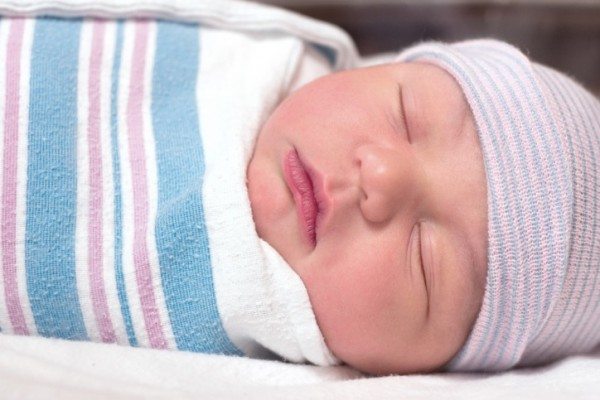
Swaddling & SIDS: A Common Sense Look at “That Study”
A study (published in this month’s Pediatrics) that looks into a possible connection between SIDS and swaddling has hit the Internet, and hoo boy, are people freaking out. Headlines like this one aren’t helping things. Is your baby swaddled right now? OMG YOUR BABY IS PROBABLY GOING TO DIE EVERYBODY PANIC.
Let’s all calm down and slow our roll, just a bit.
First, I highly recommend that everyone actually go and read the paper itself. It is not long, yet very detailed and well-written. And you’ll quickly see that some of the “reporting” on this study is quite flawed, and in a few cases, downright inaccurate and missing the point entirely. (This piece by The Atlantic, on the other hand, does a much better job of separating the facts from the panic.)
Second, I got on the phone this morning and spoke to Dr. Anna S. Pease, the lead writer and researcher of the paper published in Pediatrics itself. She was lovely, grateful the paper is getting attention, albeit not for SWADDLING = DEFINITELY SIDS reasons, which is not at all what their research concluded. Strip away the fear-mongering headlines, and the message she and the team want to get out there is simple, yet massively important:
- Put your baby, swaddled or unswaddled, ON THEIR BACK TO SLEEP.
- When your baby begins to show signs of rolling over, STOP SWADDLING FOR SLEEP.
If this sounds like common sense to you, congratulations! You are not the audience this paper is hoping to reach.
But unfortunately, the SIDS studies the team looked at contain the sad, tragic evidence that there ARE parents who put swaddled infants to sleep on their tummies or sides. And there are babies being swaddled to sleep long after they are capable of breaking loose and/or rolling over. And among this group of babies, the risk of SIDS is indeed higher.
(You’ll notice I’m including the phrase “to sleep/for sleep” quite a bit. Dr. Pease wanted to remind everyone that there are MANY reasons parents swaddle, for feeding, calming, etc. This study looked at swaddling “for sleep,” so please don’t extrapolate that the basic, simple act of swaddling your baby carries some inherent risk.)
As for the swaddled babies who were put to sleep on their backs and still died of SIDS, because the team could not take into account other risk factors — including WHERE the baby was put to sleep, whether the mother smoked, whether the swaddle was done correctly or too loose, etc. — the evidence was simply not significant enough to recommend against all swaddling. (Despite what the NY Times and Washington Post headlines seem to suggest.) It simply reaffirmed more things we already know about best sleep practices and SIDS prevention, and that these practices may apply to swaddled babies as well.
I asked Dr. Pease whether the four studies the team analyzed were from areas where there has been a concerted effort to educate parents via the Back To Sleep campaign, and she confirmed that yes, they were. Which is why they were, in the end, looking at very small numbers of SIDS cases. But unfortunately, it’s clear that some parents still aren’t getting the sleep position message, or are choosing to ignore it. And that’s why this paper was written. Not to scare you, not to cast swaddling as the new SIDS bogeyman, but to reiterate how important your baby’s sleep position and sleep environment is.
She asked me to hammer that message home as hard as I could, so let’s say it all again, with feeling:
- All babies, swaddled or unswaddled, should be put flat on their backs to sleep. Not on their sides, not on their tummies.
- If you do swaddle, make sure you’re doing it correctly (Watch a YouTube demo or five.) Baby’s face should be completely clear of the blanket and swaddled tightly so nothing comes loose. (I still highly recommend the Miracle Blanket as it easily provides a proper, super-safe swaddle.)
- Do not let your baby sleep on a couch or any uneven surface where they might roll off or over. Keep their sleep area free of toys and loose blankets/sheets/pillows.
- Maintain a smoke-free household. Do not sleep with your baby while drunk or high.
- As soon as your baby shows signs of rolling over, cease swaddling them to sleep. You can continue to swaddle for feeding or calming, but DO NOT SWADDLE FOR SLEEP.
That last point, in my opinion, needs to be emphasized more, even (especially?) among those of us who might read all the other points and go “NO DUH.” I don’t think my pediatrician ever asked if I was still swaddling to sleep once my babies neared the rolling-over window. I think I used the “they can break free of the swaddle and end up in bed with a loose blanket” as my sign to stop, without really thinking of what could happen if they managed to roll onto their tummy and then be unable to push themselves back up or over. So for that reason, I am grateful this paper is getting so much attention, as that’s an important takeaway for swaddlers.
In the end, if your baby benefits from swaddling for sleep (and sleeps in a safe environment on his/her back), this study should in no way alarm you. Feel free to share this post or The Atlantic’s take with anyone freaking out on Facebook, and recommend they read the actual paper as well. It’s never a bad thing for the sleep position message to get a burst of exposure, though, so let’s all focus on that, rather than knee-jerk headline panic.
\
Photo source: Stocksy

